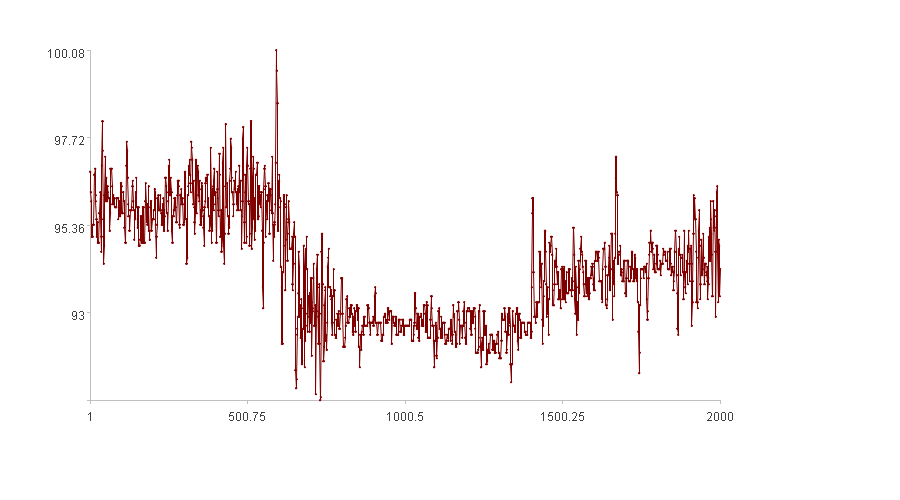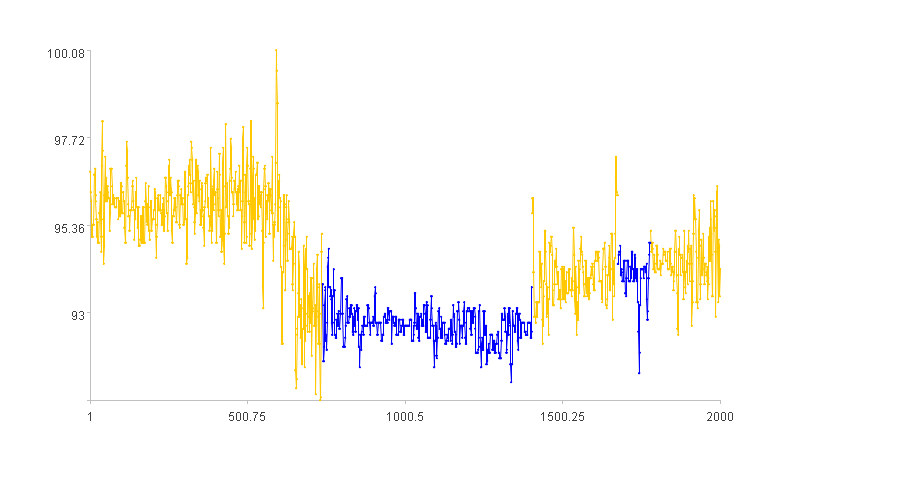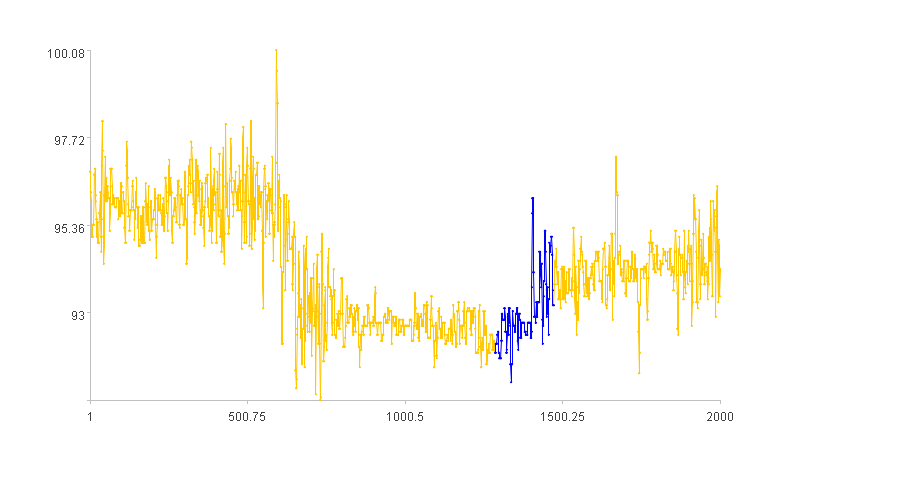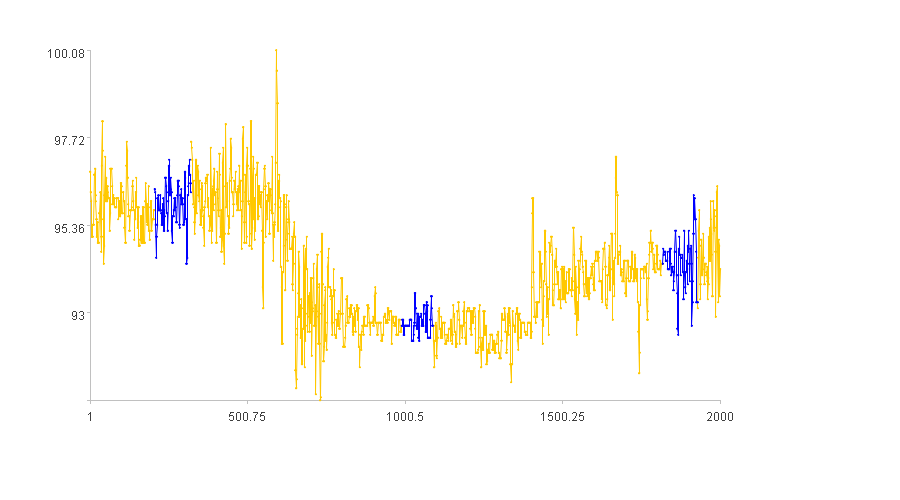5.5 Examples of shape discovery
1. Filtering for curve segments with values between [90, 95]
No need to calculate feature indices or project parameters.
Parameter settings:
Let Nm denote the combination of feature index names:
Nm=[“Value”]
Let Ag denote the range of values:
Ag=[[90,95]]
Let dut denote the shape length range:
dut=[100,10000]
SPL routine:
| A | B | |
|---|---|---|
| 1 | =file(“1Ddata.csv”).import@tc() | /Table sequence containing time series X |
| 2 | [Value] | /Nm |
| 3 | [[90,95]] | /Ag |
| 4 | [100,10000] | /dut |
| 5 | =A2.(~/“>=”/“number(”/$[A3(]/#/$[)(1)]/“)”/“&&”/~/“<=”/“number(”/$[A3(]/#/$[)(2)]/“)”).concat(“&&”) | /Feature index filtering condition |
| 6 | =A1.pselect@a(eval(A5)) | /Feature index indices Id |
| 7 | =A6.group@u(~-#) | /Adjacent indices form a segment Ids |
| 8 | =A7.select(~.len()>=A4(1)&&~.len()<=A4(2)) | /Filter Ids’ by length |
| 9 | =A1.(Value) | /Time series X |
| 10 | =A8.(A9(~)) | /Specified shape Sp |
Calculation result example:
Time series X:

The x-axis represents the index, and the y-axis represents the values of X.

The blue segments in the figure represent the discovered shapes.
2. Rising curve segments
The rise-fall index L needs to be used. Before calculating L, the main line M needs to be fitted. In addition, parameter projection is required.
Parameter settings:
Let K’ denote the observation level:
K’=600
Let Nm denote the combination of feature index names:
Nm=[“L”]
Let Ag denote the range of values:
Ag=[[0.1,1]]
Let dut denote the shape length range:
dut=[100,10000]
SPL routine:
| A | B | |
|---|---|---|
| 1 | =file(“1Ddata.csv”).import@tc() | /Table sequence containing time series X |
| 2 | 600 | /K’ |
| 3 | [L] | /Nm |
| 4 | [[0.1,1]] | /Ag |
| 5 | [100,10000] | /dut |
| 6 | =A1.(Value) | /Time series X |
| 7 | =2*power(4,lg(A2/15,2)-1) | /Balancing coefficient K |
| 8 | =fit_main(A6,A7) | /Main line M |
| 9 | =A2/40 | /Index interval k |
| 10 | =Lift(A8,A9) | /Rise-fall index L |
| 11 | =[A10.min(),A10.max()] | /Min & max of feature index |
| 12 | =[A11] | |
| 13 | =A4.((idx=#,~.(arg_throw(~,A12(idx)(2),A12(idx)(1))))) | /Parameter projection |
| 14 | =A1.derive(A10(#):L) | /Table sequence T |
| 15 | =A3.(~/“>=”/“number(”/$[A13(]/#/$[)(1)]/“)”/“&&”/~/“<=”/“number(”/$[A13(]/#/$[)(2)]/“)”).concat(“&&”) | /Feature index filtering condition |
| 16 | =A14.pselect@a(eval(A15)) | /Feature index indices Id |
| 17 | =A16.group@u(~-#) | /Adjacent indices form a segment Ids |
| 18 | =A17.select(~.len()>=A5(1)&&~.len()<=A5(2)) | /Filter Ids’ by length |
| 19 | =A18.(A6(~)) | /Specified shape Sp |
Calculation result example:

3. Curve segments with high oscillation frequency
The frequency index Vf needs to be used. Before calculating Vf, the main line M and fluctuation curve Wv need to be fitted. In addition, parameter projection is required.
Parameter settings:
Let K’ denote the observation level:
K’=600
Let Nm denote the combination of feature index names:
Nm=[“L”]
Let Ag denote the range of values:
Ag=[[0.1,1]]
Let dut denote the shape length range:
dut=[100,10000]
SPL routine:
| A | B | |
|---|---|---|
| 1 | =file(“1Ddata.csv”).import@tc() | /Table sequence containing time series X |
| 2 | 600 | /K’ |
| 3 | [Vf] | /Nm |
| 4 | [[0,1]] | /Ag |
| 5 | [100,10000] | /dut |
| 6 | =A1.(Value) | /Time series X |
| 7 | =2*power(4,lg(A2/15,2)-1) | /Balancing coefficient K |
| 8 | =fit_main(A6,A7) | /Main line M |
| 9 | =A2/40 | /Index interval k |
| 10 | =A6–A8 | /Fluctuation curve Wv |
| 11 | =VFre(A10,A9) | /Frequency index Vf |
| 12 | =[A11.min(),A11.max()] | /Min & max of feature index |
| 13 | =[A12] | |
| 14 | =A4.((idx=#,~.(arg_throw(~,A13(idx)(2),A13(idx)(1))))) | /Parameter projection |
| 15 | =A1.derive(A11(#):Vf) | /Table sequence T |
| 16 | =A3.(~/“>=”/“number(”/$[A14(]/#/$[)(1)]/“)”/“&&”/~/“<=”/“number(”/$[A14(]/#/$[)(2)]/“)”).concat(“&&”) | /Feature index filtering condition |
| 17 | =A15.pselect@a(eval(A16)) | /Feature index indices Id |
| 18 | =A17.group@u(~-#) | /Adjacent indices form a segment Ids |
| 19 | =A18.select(~.len()>=A5(1)&&~.len()<=A5(2)) | /Filter Ids’ by length |
| 20 | =A19.(A6(~)) | /Specified shape Sp |
Calculation result example:

4. Curve segments exhibiting oscillating divergence
The amplitude rise/fall index VaL and frequency rise/fall index VfL need to be used. Before calculating them, the main line M, fluctuation curve Wv, amplitude index Va, frequency index Vf, amplitude main line VaM, and frequency main line VfM need to be fitted. In addition, parameter projection is required.
Parameter settings:
Let K’ denote the observation level:
K’=600
Let Nm denote the combination of feature index names:
Nm=[“VaL”, “VfL”]
Let Ag denote the range of values:
Ag=[[0,1],[-0.5,1]]
Let dut denote the shape length range:
dut=[100,10000]
SPL routine:
| A | B | |
|---|---|---|
| 1 | =file(“1Ddata.csv”).import@tc() | /Table sequence containing time series X |
| 2 | 600 | /K’ |
| 3 | [VaL, VfL] | /Nm |
| 4 | [[0,1],[-0.5,1]] | /Ag |
| 5 | [100,10000] | /dut |
| 6 | =A1.(Value) | /Time series X |
| 7 | =2*power(4,lg(A2/15,2)-1) | /Balance coefficient K |
| 8 | =fit_main(A6,A7) | /Main line M |
| 9 | =A2/40 | /Index interval k |
| 10 | =A6–A8 | /Fluctuation curve Wv |
| 11 | =Amplitude(A10,A9) | /Amplitude Index Va |
| 12 | =fit_main(A11,A7) | /Amplitude main line VaM |
| 13 | =Lift(A12,A9) | /Amplitude rise/fall index VaL |
| 14 | =VFre(A10,A9) | /Frequency Index Vf |
| 15 | =fit_main(A14,A7) | /Frequency main line VfM |
| 16 | =Lift(A15,A9) | /Frequency rise/fall index VfL |
| 17 | =[A13.min(),A13.max()] | /Min & max of VaL |
| 18 | =[A16.min(),A16.max()] | /Min & max of VfL |
| 19 | =[A17,A18] | /Min & max of feature index |
| 20 | =A4.((idx=#,~.(arg_throw(~,A19(idx)(2),A19(idx)(1))))) | /Parameter projection |
| 21 | =A1.derive(A13(#):VaL,A16(#):VfL) | /Table sequence T |
| 22 | =A3.(~/“>=”/“number(”/$[A20(]/#/$[)(1)]/“)”/“&&”/~/“<=”/“number(”/$[A20(]/#/$[)(2)]/“)”).concat(“&&”) | /Feature index filtering condition |
| 23 | =A21.pselect@a(eval(A22)) | /Feature index indices Id |
| 24 | =A23.group@u(~-#) | /Adjacent indices form a segment Ids |
| 25 | =A24.select(~.len()>=A5(1)&&~.len()<=A5(2)) | /Filter Ids’ by length |
| 26 | =A25.(A6(~)) | /Specified shape Sp |
Calculation result example:

SPL Official Website 👉 https://www.esproc.com
SPL Feedback and Help 👉 https://www.reddit.com/r/esProcSPL
SPL Learning Material 👉 https://c.esproc.com
SPL Source Code and Package 👉 https://github.com/SPLWare/esProc
Discord 👉 https://discord.gg/sxd59A8F2W
Youtube 👉 https://www.youtube.com/@esProc_SPL


